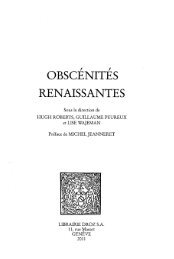Download (3398Kb) - ePrints Soton - University of Southampton
Download (3398Kb) - ePrints Soton - University of Southampton
Download (3398Kb) - ePrints Soton - University of Southampton
Create successful ePaper yourself
Turn your PDF publications into a flip-book with our unique Google optimized e-Paper software.
gamete production at low population density, and (b) smaller size with lower gamete<br />
production at higher population density. The results obtained by Levitan (1991)<br />
suggest that influence <strong>of</strong> population density on fertilization success should be<br />
recognized and incorporated into an assessment <strong>of</strong> the reproductive potential <strong>of</strong> an<br />
organism. These essentially indicate that the influence <strong>of</strong> body size on fertilization<br />
success and reproductive output in shallow-water invertebrates is not important. If a<br />
gain in fertilization success balances the cost <strong>of</strong> reduced gamete production, then<br />
small-sized organisms living at high population density may be just as fecund as large<br />
organisms living a low population density. However, the converse is true to species<br />
living in the deep sea where the low population densities would increase the<br />
importance <strong>of</strong> body size.<br />
The most recent models <strong>of</strong> life-history theory explain the evolution <strong>of</strong> patterns<br />
<strong>of</strong> covariation in reproductive traits based on demographic parameters and in relation<br />
to variable environmental conditions (Ramirez-Llodra, 2002). The Winemiller-Rose<br />
Model is based on a modification and extension <strong>of</strong> the two-dimensional r-K model<br />
(McArthur and Wilson, 1967; Pianka, 1970) by incorporating three major<br />
demographic components <strong>of</strong> fitness (fecundity, survivorship <strong>of</strong> juveniles and age at<br />
maturity). The model implies that trade-<strong>of</strong>fs among life-history traits are based on<br />
physiological and ecological constraints that ultimately select for genetic correlations.<br />
In the Winemiller-Rose Model, the r strategy is divided into periodic and<br />
opportunistic strategists. The periodic strategists similar to the classical r strategists<br />
have high fecundity and low juvenile survivorship. They differ, however, in that they<br />
are large, long-lived and have late maturation (Ramirez-Llodra, 2002). The periodic<br />
strategy maximizes age-specific fecundity at the expense <strong>of</strong> turnover time and<br />
83
















